March 11 -17, 2012:
Issue 49
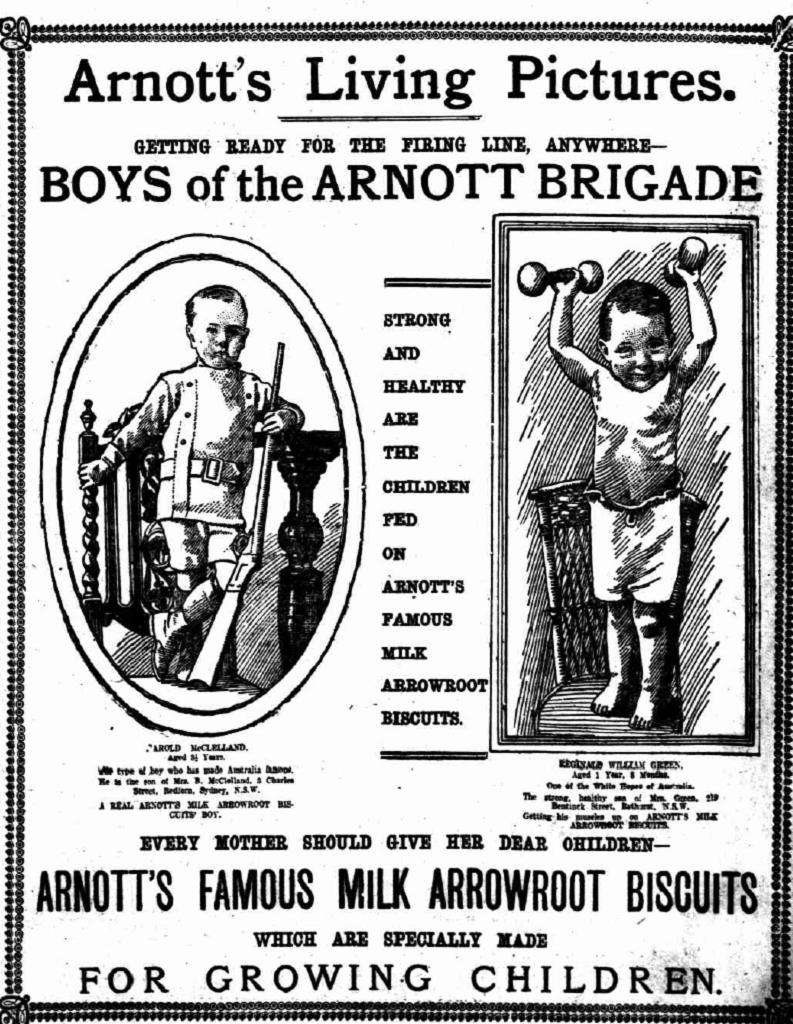
Arrowroot advertisement, 1917, Sydney Morning Herald
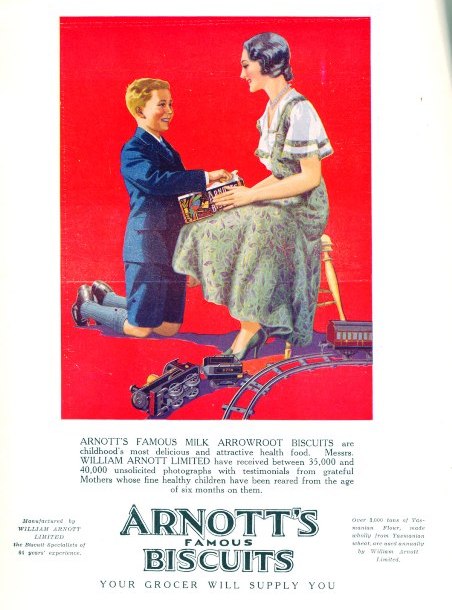
Illustrated Tasmanian Mail, (1932) Arnott's biscuits advertisement from the Illustrated Tasmanian Mail, December 1, 1932. From; University of Tasmania Library Special and Rare Materials Collection, Australia. (Unpublished)
|
|
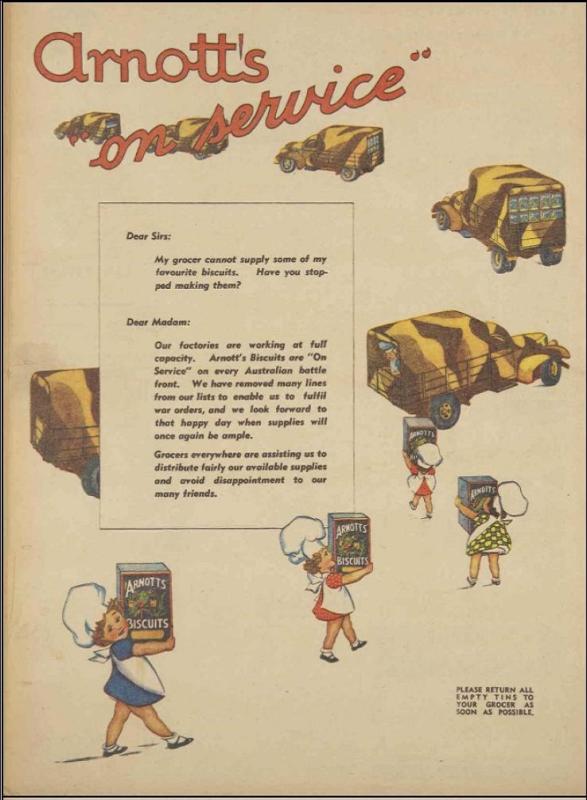
Advertising. (1943, January 16). The Australian Women's Weekly (1933 - 1982), p. 24. Retrieved from http://nla.gov.au/nla.news-article46445995
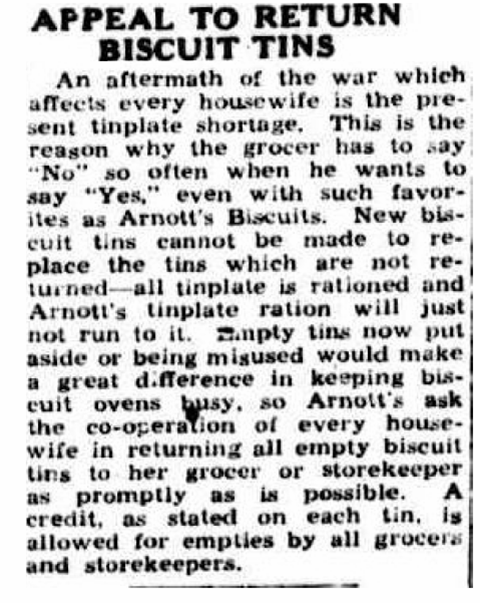
APPEAL TO RETURN BISCUIT TINS. (1947, June 19). Barrier Miner (Broken Hill, NSW : 1888 - 1954), p. 3. Retrieved from http://nla.gov.au/nla.news-article48499604 Advertisements alike these appeared in every newspaper around the country up until 1947; there was a post-war tin shortage. Some sources state the tin shortage lasted well into the 1950's.
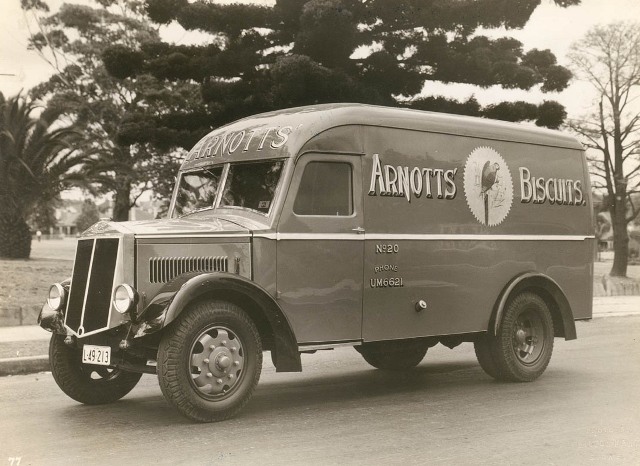
Arnott's flatbed trucks (nos. 17, built by C.Ibbotson, King St, Newtown, & 22) and van (no. 20, with sloping halved radiator), [ca. 1935-1940] / Milton Kent Digital Order No. a449002, Courtesy State Library of NSW Original vans were bright red from 1920’s, prior to then deliveries were made by horse and buggy outfits.
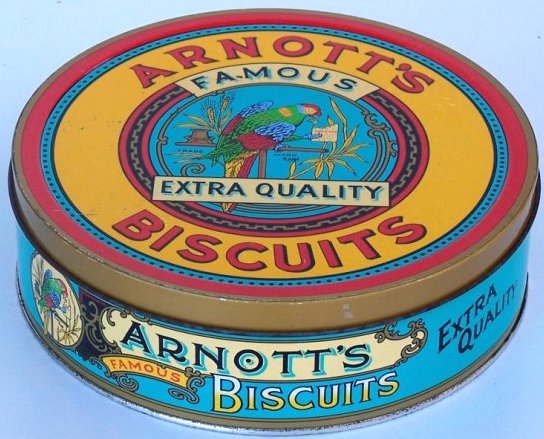
Reproduction of a 1920's tin
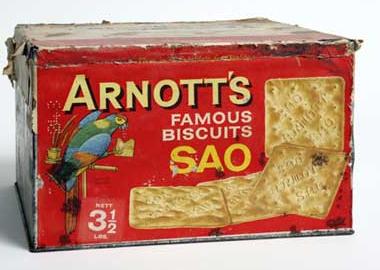
1950's 3 and a half pounds Sao tin
Copyright Pittwater Online News, 2012. All Rights Reserved.
Arnott’s Australian Biscuit Tins
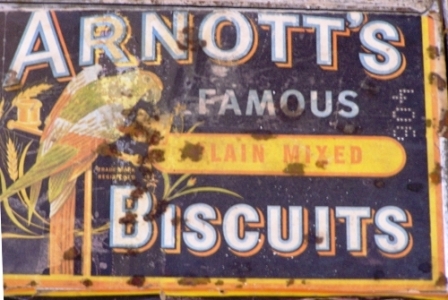
Early Arnott's Tin in Newcastle Museum
Fetching between $1700 to $2000.00 for earlier tins, and some asking $24.00 for tins only a few years old, all who have Arnott’s biscuit tins to store your own homemade Anzacs and cakes in, may want to relegate them, and their attractive finishes, to collectors items ands spare them the rust caused by water. Despite the Arnotts Company becoming the property of Campbell’s Soup (US) in 1997, many people collect these tins in each year’s edition (usually at Christmas or in other celebratory anniversaries and issues to celebrate events) due to their ‘Australian’ connection. Arnott’s was considered an ephemeral Australian company; during the Depression they cut back workers hours to three days a week rather then dismiss people. They created and sent special biscuits in soldiers only tins for our troops during both WWI and WWII. They sold biscuits to many places overseas and around 10000 tons per year in Australia annually (1930’s).
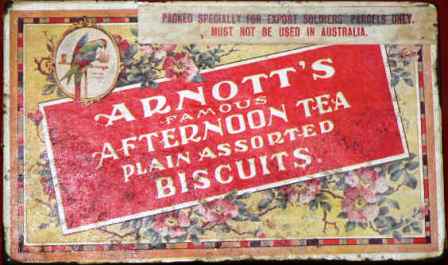
Used to store marbles, repair kits, photos, with some reports of people’s ashes also being buried in them, the Arnott’s biscuit tin has become part of an Australian heritage to some and one of those collectors’ items that increases in value when not kept for aesthetic reasons.
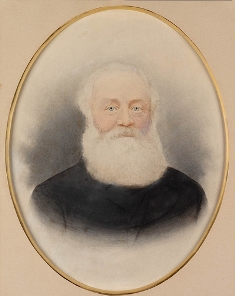 William Arnott, was born in
1827 (1827-1901) in Pathhead near Kirkcaldy, Fife, Scotland and emigrated with
his brother David to Australia in 1848. The milk arrowroot biscuit stemmed from
an idea when crossing the ocean to Australia as this formed part of the diet of
all those on board. He began a baker’s business in Maitland but after floods in
1859 and again in 1861 moved to Hunter Street, Newcastle.
William Arnott, was born in
1827 (1827-1901) in Pathhead near Kirkcaldy, Fife, Scotland and emigrated with
his brother David to Australia in 1848. The milk arrowroot biscuit stemmed from
an idea when crossing the ocean to Australia as this formed part of the diet of
all those on board. He began a baker’s business in Maitland but after floods in
1859 and again in 1861 moved to Hunter Street, Newcastle.
In 1875 a new enterprise, William Arnott's Steam Biscuit Factory opened in Newcastle. In 1900 the first Arnott’s tins began appearing, as a means to store biscuits, keeping them fresh. The first Sydney factory was opened at Forest Lodge in 1894. In 1905, the Arnott family (William had seven sons and five daughters through two marraiges) wanting to expand, decided that a larger factory was required. Requiring access to the railway for transportation, the Arnott’s purchased a six and half acre site at Homebush in 1906. The factory was designed by architect Charles Slatyer and built in 1907 at a cost of £10,400. Until 1940 biscuits were sold by weight in 14 pound tins.
Arnott’s tins stamped with the Homebush address are very 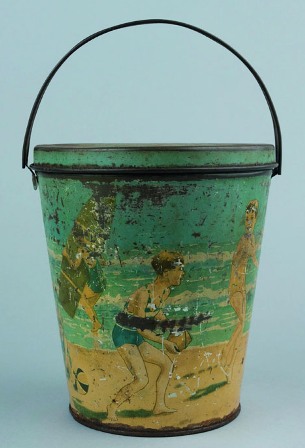 popular. One of the most sought and valuable Arnott’s biscuits tins
is the "beach bucket" containers produced by Arnott's at Homebush during the
1930’s, in fact all tins made before the war (II) can be worth up to $2000 if
found in very good condition. We found one Tinplate beach bucket style container
with a lid, featuring images of families at the seaside, impressed to the base
'William Arnott Ltd - Biscuit Manufactures - Homebush NSW' Australia, circa 1920
(?), 26 cm high, 16 cm diam (to Right).
popular. One of the most sought and valuable Arnott’s biscuits tins
is the "beach bucket" containers produced by Arnott's at Homebush during the
1930’s, in fact all tins made before the war (II) can be worth up to $2000 if
found in very good condition. We found one Tinplate beach bucket style container
with a lid, featuring images of families at the seaside, impressed to the base
'William Arnott Ltd - Biscuit Manufactures - Homebush NSW' Australia, circa 1920
(?), 26 cm high, 16 cm diam (to Right).
Another rare and collectible Arnott's tin was the castanet tin which can be worth even more. Several Arnott's promotional items were made, and the glass barrels used to display biscuits on shop counters are also very desirable. The value of Arnott's tins has increased since the company was acquired by Campbell Soup Company in 1997. While " Any featuring early versions of the famous parrot logo (a Mexican species, according to legend) are especially prized. Some collectors only want the parrot in its various representations". (James Cockington . 2007. It takes the biscuit. September 12, 2007. SMH)
The first printing and branded tins were made in 1868 by the UK biscuit company Huntley & Palmer, who introduced the Ben George tin (named after Benjamin George, who patented the new transfer-printing process and the first lithographic tin ever made, the “Ben George” tin.).
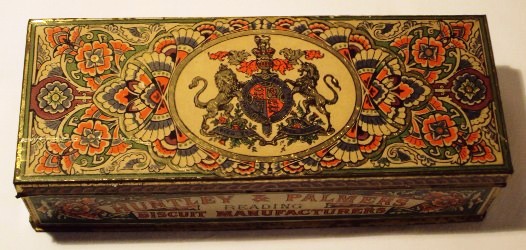
Vintage tins are usually heavier then more modern version due to the materials used, and their inks and paints will have faded due to age. Always try and collect those that are not rusted or damaged. Some state not to let the early transfer print tins get wet as this will cause a ‘bloom’ on the surface and ruin them.
Further:
Arnotts History Slideshow: http://www.arnotts.com.au/history.aspx
Buying Arnotts Tins: http://cookiejars.au-dot.com/buy/arnotts+tin
SMH Report on 2007 Biscuit Tin Exhibition at Musuem of Sydney: http://www.smh.com.au/news/investment/it-takes-the-biscuit/2007/09/10/1189276630940.html
Above in text: William Arnott, ca. 1890 - portrait, Date of Work, ca. 1890 Digital order no. a928166, courtesy State Library of NSW
WANTED, a Confectioner, that can work in the Bakery house, and boil sugar. Apply to Mr. WILLIAM ARNOTT. West Maitland. Advertising. (1856, January 21). Empire (Sydney, NSW : 1850 - 1875), p. 1. Retrieved from http://nla.gov.au/nla.news-article60172702
ARNOTT'S CAKES AND BISCUITS.
Although Arnott's principal
establishment is at Newcastle, in all provision shops of Sydney there are to be
found at the present time "Arnott's Christmas cakes." The popularity of these
goods is shown by the ever increasing demand, and the quality of them is so good
that many thrifty housewives are beginning to give up the making of cakes on the
ground that they can get these nice cakes cheaper than they could make them.
Although at this time of the year special attention is directed to the Christmas
cakes, the huge variety of biscuits produced must not be forgotten. By far the
largest biscuit-makers south of the line, the Messrs. Arnott have much to be
proud of. Mr. William Arnott established the business in 1868 on small lines.
Since then its ramifications have extended through all New South
Wales.
ARNOTT'S CAKES AND BISCUITS. (1894, December 20).
The Sydney Morning Herald (NSW : 1842 - 1954), p. 3. Retrieved from http://nla.gov.au/nla.news-article13990166
ARNOTT'S BISCUITS.
Arnotts biscuits are well displayed in all the
leading grocers' shops, and are in ever-increasing demand from those to whom
quality appeals. Messrs Arnott Ltd have recently put on the market a few dainty
and appetising new varieties, such as "King's Own" (an assortment of fancy
biscuits especially suitable for the boys at the Front), "Good Luck" (a
delicious shortbread), "Adora Cream Wafers," "Scotch Shortbread Fingers," " Date
Shells," "Selected Afternoon Teas" (fancy line), " Mab Cake." " Mario " and
"Creamy Chocolate," besides the old- established favourites, Arnott's Milk
arrowroot '"the children's food'), Sao Creams, Zuzu Mixed, Fairy Cakes, and a
host of others
ARNOTT'S BISCUITS. (1916, December 5).
The Brisbane Courier (Qld. : 1864 - 1933), p. 3. Retrieved from http://nla.gov.au/nla.news-article20095959
BISCUITS. Mr. C. R. Arnott's Visit. Among the passengers from South by the
Canberra, was Mr. Campbell R. Arnott of the well-known firm of biscuit
manufacturers, William Arnott Ltd, a name which Is a house hold one throughout
Australia. Mr. Arnott who is connected with the advertising side of Arnott's
extensive business. Is paying his first visit to North Queensland, and he has al
ready been -very favorably Impressed by the passage through Whitsunday Passage
and Townsville, In an Interview, Mr. Arnott stated his firm was doing an
ever-expanding trade In Queensland. It was because of this that Messrs. R. M.
Gow and Co., Arnott's Queensland representatives, had opened a branch In
Townsville, and fresh stocks were sent here weekly direct from the factory to
give North Queensland retailers the best service possible. They were deter mined
to maintain service, along with the high quality of their products. It was
Interesting to learn from Mr. Arnott that there Is no arrowroot In Arnott's
arrowroot biscuits. 'Arrowroot Is injurious to the baby's stomach,' said Mr.
Arnott 'The biscuit has been given merely a trade name. Now, the shredded wheat
biscuit describes exactly what It Is. It the essentials of the grain plus that
contains the whole of the wheat— all roughage which Is so essential to healthy
digestion.' The mention of wheat prompted a remark from Mr. Arnott that he did
not like to see it selling at so low a price. He liked everybody to be doing
well, he said. For some to be doing badly, simply started a vicious circle. But
things were not too bad now — not depressed. Times were nor mal, not
supernormal. These were not boom times, nor had they a right to expect boom
times yet ; they would be a long time coming, he thought. But why should we not
be absolutely content with the normal for a while 7 Alterations in the tariff
had not assisted his firm, said Mr. Arnott they had stood on their own legs for
60 or 70 years, and did not fear foreign competition. On the contrary
his firm was Invading foreign markets—Japan, China, the Malay States, Java,
Egypt and all parts of Polynesia. The factory makes 115 standard lines
of biscuits, he said, and produces one new brand on the average once a month.
The main part of the machinery used in their manufacture still came from
England, but all additions and repairs were executed In Australia. 'And, think
of the vast quantities of Australian raw materials that go into the production
of those 10 000 tons of biscuits,' exclaimed Mr. Arnott 'And think of the vast
quantity of Queensland sugar that is melted into them. I'm glad to be in the
land where It grows. Mr. Arnott went on to Cairns by the Canberra. He returns to
Townsville by the vessel and goes by train to Rockhampton, and back
south.
ARNOTT'S BISCUITS. (1933, March 21). Townsville
Daily Bulletin (Qld. : 1885 - 1954), p. 4. Retrieved from http://nla.gov.au/nla.news-article61379594